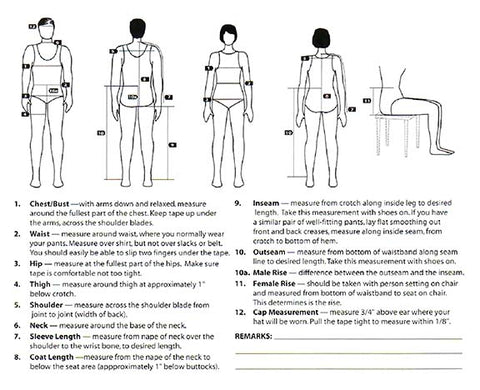Sizing Charts and How to Measure
Read the following information to choose the correct size.
For best results, DO NOT take your own measurements. Stand up straight but relaxed, wearing best fitting undergarments, or if preferred, clothing that follows the body's contour. Have someone hold the measuring tape so that it is straight, snug and lies smoothly but doesn't indent the body.
Refer to the visual image below the size charts for more information.
*Due to manufacturers slight differences, the following is a general guide.

Footwear Sizing Info
Fit is an essential ingredient in footwear. Properly fit shoes and boots will be comfortable to wear right out of the box; they don't need to be "broken in." There are few simple guidelines that if followed can make the process easy:
Tap your heel back in the heel cup and lace the boot. The boot should feel snug across the ball, around the instep, and in the heel. The arch should be comfortably supported and the toes should be free to wiggle and curl.
The toes should not jam into the front of the boot. Check this by lightly tapping the toe of the boot into the floor. If the boot fits correctly, the toes should gently touch the end of the boot.
Footwear is made in an array of widths in order to provide our customers with the best fit possible. See chart below for width descriptions:
B = Narrow width
C = One width wider than B
D = Average or medium width
E = the narrower of the “Wide” widths
EEE = our widest width
M = Equal to a “D” or medium
W = Equal to an “E” or wide width
EW = Equal to an “EEE” or extra wide
Whenever possible have your foot measured with a Brannock device by a shoe care professional. Using a Brannock device is the most accurate method to determine your shoe size and width.
Shoe Care
Here is everything you need to know to ensure your boots or shoes are in great shape now and in the future
Store shoes and boots with a shoe tree. This will help the shoe retain its shape while drying it properly. Never store or dry shoes near direct heat.
To extend the life of your footwear it is recommended to alternate your shoes daily. Pairs alternated everyday and stored overnight with shoetrees will typically last more than twice as long as a single pair of shoes worn everyday.


Care for Leather Information
For cleaning Leather
Remove excess dirt with a soft brush.
For the most effective shine remove the laces before you start polishing.
If using a polish or cream be sure to apply evenly with a brush or soft cloth. Once polish has dried buff to a shine using a natural bristle brush.
Instant shine liquids are also available. Remove excess dirt then evenly apply liquid to leather portion of your shoe or boot. These formulations dry to a shine without buffing.
For cleaning leather or rough side out leather
Leathers unique properties allow for more liberal cleaning techniques than other rough out boots.
Allow dirt to dry before cleaning. Brush dried dirt from boot with a medium bristled brush.
After removing loose dry dirt, a mixture of warm water and mild dish soap can be applied with a medium bristle brush. Rinse with clear water and repeat if necessary.
Allow to dry naturally.
Rebrush the entire boot with a clean medium bristle brush.
